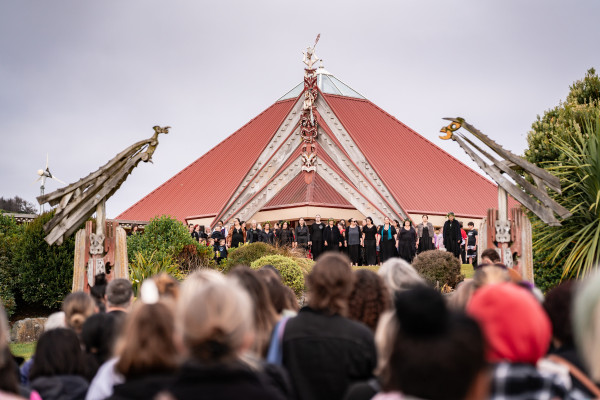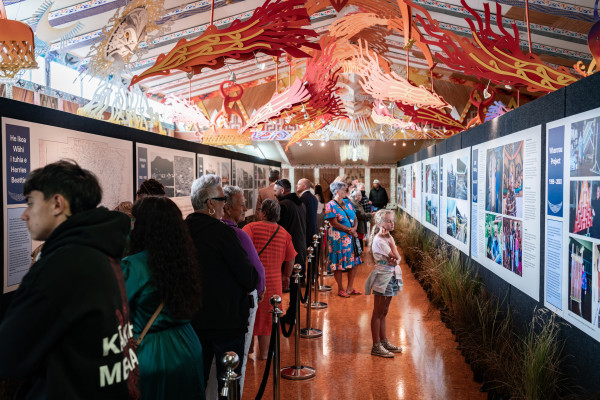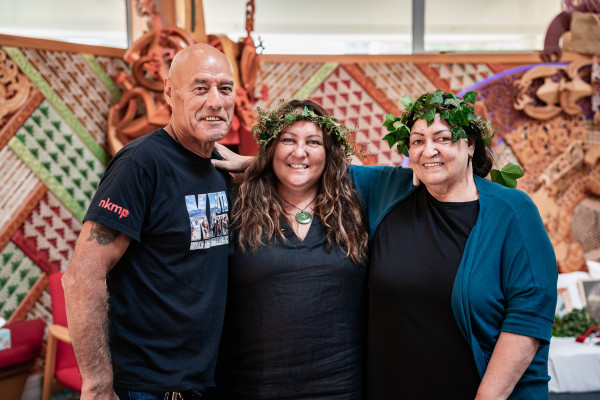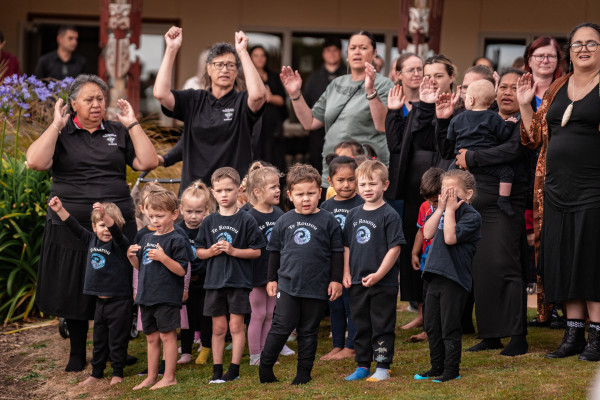Awarua celebrate 40 years of Te Rau Aroha Marae
Mar 3, 2025

Te hau kainga welcoming manuhiri onto the marae during pōhiri
Te Rau Aroha Marae – 40th Anniversary
7 - 9 February 2025
Written by Manuariki Tini
Te Rau Aroha e
E karanga atu nei
Ki ngā manuhiri
Kua eke mai nei
Over three days, the hau kainga from Awarua, the Bluff - welcomed whānau and manuhiri from near and far to celebrate and commemorate, the 40th Anniversary of our marae, Te Rau Aroha.
This event was an opportunity to bring all our people back together. And to share the history, moemoeā and creation brought to fruition by a group of young people, predominately females, aged in their early 20’s to mid-40’s, dubbed, the Original Marae Whanau.
The marae was officially opened with the support of thousands, debt-free, on 9th February 1985.
Whakarongo mai
Ki a mātou e mihi nei
Haere haere mai rā
Ki Awarua e
The marae was built by many hands – Ngāi Tahu descendants both local and afar, and mātāwaka whānau residing in the Bluff and southern parts of the island. This also included our local Pasifika families, Bluff residents, and the wider southern community.
Due to the numerous hononga, the external support and awhi came from near and far— Te Arawa, Tainui, Tūwharetoa, Te Ati Awa, Ngapuhi, Ngāti Awa, Ngāti Porou, and many, many more. It was imperative to acknowledge these hononga - the ties between most are still very strong today. This kōrero was mentioned during both pōhiri.
Ki te whakanuia mātou
A ngā iwi
Nau Mai Haere Mai
Kia Ora Rā!
Every space of the marae was opened and utilised for all to enjoy. The event started with a walk through our Māori House – Tarere ki Whenua Uta. Many people have not been into this whare for a long time, and most manuhiri had never entered this building at all. Once through, they were directed to the waharoa and greeted by our manuao, Dion Williams. This is where our manuhiri gathered and waited for the pōhiri to begin.
Four kaikaranga merged forward to welcome our guests, whilst a haka pōhiri was led from behind. The Paetapu were prepared, and the formalities went accordingly. After each kaikōrero, waiata kīnaki specific to our marae and iwi were delivered, our mokopuna from Te Rourou Whakatipuranga o Awarua stood strong to support their pae.
Kai paramanawa and kai o te rā, were held off-site. Two venues were utilised to feed the masses - Bluff School, and the Bluff Senior Citizens Centre. Transport to safely deliver kaumātua was provided by Nga Kete Matauranga Pounamu Charitable Trust. Attendees also had the option to support our local Kai karts: Halo’s Hangi, Bluff Kitchen and a local tamaiti, Kobe-Jak Ryan, fundraising for his sporting commitments. Kai Reka and Karaage Me from Invercargill came to support the kaupapa as well.
After paramanawa, our manuhiri returned to the marae to browse through pākihi Māori (stalls), which were based in a large marquee on the marae grounds. There was rongoā māori, taonga and pounamu, whakakai and heru, kete, poi, clothing/merchandise and mahi whakairo, all displayed for purchase.
From the pākihi, the manuhiri then entered the wharekai to begin their journey through our Historic Maze. This exhibition was brought to fruition by Dr Michael Stevens, Takerei Norton, Sarah Christie and others behind the scenes from Archives. Hours of research, discussions and interviews were had – and those that contributed were acknowledged.

Manuhiri walking through the historical maze in the wharekai
The exhibition filled the entire wharekai. Two-metre-high display boards were erected to hold the large posters full our rich history. And to offset from the posters and boards, native plants were delivered for use by the amazing taiao kaimahi from Bluff Hill Motupōhue Environment Trust. It was a sight to see.
The height of the boards was key for visitors to “look up” at all the tukutuku, toi māori, te whitinga o te rā, me te tōnga o te rā, as well as ngā manu a Tane, me ngā tamariki a Tangaroa. In chronological order, we shared: - local kōrero; sites of significance; images; “the emergence, the development and evolution” of our entire marae; memories; traditional maps and placenames; our stories; our whys; our people; and most importantly, the history of our marae.
Displayed throughout the hall were family korowai, pake and kākahu – all crafted inside the marae by local whānau. The original office space (known as the tamariki room when we were children) was converted into a virtual reality and display room. The VR team who travelled from Ōtakou, shared captured korero and footage of Dean Whaanga and the late Bubba Thompson sharing history of each tupuna kuia, pakitara and pou inside our tupuna whare, Tahu Pōtiki. This concluded the journey inside the wharekai.
The manuhiri then made their way to our wharenui, our wharerau, which was transformed into a wharemate. As they entered through the doors, they were welcomed by some of the remaining originals from 1985. Adorned with parekawakawa, they introduced the manuhiri to the numerous photos of loved ones that had passed since the opening in 1985–individuals and whānau who were instrumental in the development of the marae, and those that contributed and maintained the marae since its opening.
The doors on each tupuna kuia were open, their hearts were exposed and protruding – to welcome their whanau, all whānau – and they were stunning. Greenery and foliage arrangements were placed throughout the whare, a guitar was strum and all the Aunties, now Taua were singing old familiars.
As manuhiri completed this part of the experience, they exited out the front doors of our whare, to our oko wai. This was placed strategically facing back to the marae – the intention, after reading the history of the people instrumental in the development, that the final acknowledgement – was to the actual marae; the structure, the whare! For housing us, for allowing us space, for hui, for good times and bad, for tribal gatherings – the final mihi, was to the “marae”.
Kai o te rā provided two options: non-seafood, or seafood. Our kitchen team was a small, tight crew, including Blackie Tini, 74 years young, doing the mahi behind the scenes just as he did 40-plus years ago. These tino pukumahi – know the know, can work with each other and work with kai! They improvised on the spot – and created magic to feed all the manuhiri! We even had a dedicated “sweet team” who created all my favourites – a real treat. Over 1000 panakeke (frybread) were cooked to perfection by our Mataura kui, Jennifer White; there were no leftovers.

Blackie and Te Mauri Tini, Jamahl Aerepo-Morgan and Tupu Lavea in the kāuta preparing kai
We have so much gratitude for those that gave kai and acknowledge the key relationships/hononga from whānau within the marae that made this possible. All the kaimoana and tītī that were gifted as kai aroha were cooked to perfection: some served raw in Kara cream; others battered and fried; delicacies slurped straight from a shell or a bowl; some from a shot glass or a pottle.
When lunches were devoured, tamariki went back to the marae to the Tamariki Area – this was based near Tarere. Those coordinating this area had gathered resources from the beach: paua shells, kuku, driftwood, kelp. Awarua pepeha cards of the marae were handed out and pukapuka from our local whānau were shared. They painted frames and crafts were made utilising all the natural taonga that were collected. Fence posts were also painted with kowhaiwhai and koru designs. Topped off with moko kauae and mataora stencils, and a rolling BBQ with kai, koha from our very own farms.
Whilst the tamariki enjoyed activities, buses idled at both kai venues to collect all the adults. A haerenga was created to physically visit the aforementioned sites of significance. The tour started at Ōmaui – where our whānau harvested resources for both whare. We then journeyed back towards Bluff waving to those resting at Greenpoint. A mihi was extended to Ocean Beach freezing works on our right, and Kahuariki where our tūpuna would safely land ashore after travelling back from the islands – on our left.
Along the main road, kōrero was shared about the first Māori House on the foreshore. Also, a mention of the toi māori feature on the main road, made from original wood from the old wharf with designs made from metal – depicting our mountain, tītī islands and the sea current. A small stop was included to see the section where Waitaha Hall once stood. Up Bandon Street past our ANZAC memorial urupā, to the tihi of our beautiful maunga, Motupōhue. There we stood, our feet firmly on the whenua, acknowledging the maunga we all use in our pepeha. This time, this visit, with a different lens. A lens of appreciation, a lens of awareness.
Our final visit was to Awarua, Stirling Point. We stood in awe, perfect weather, thinking of all our tūpuna whilst looking towards our islands, and out to the sea.
I cast my eyes behind me
To Hananui my anchor
I’m guided by the incandescent lights
Of Tahunui-I-Te-Raki
To my sternpost Motupōhue
I breakthrough the cresting waves
Of te Rau o Te Huia
To the comforting bay of Awarua
My people guarded safely
By Tahu Potiki to shore
To my landing place, at Kahuariki
The final stop for the adults was the Bluff Town Hall, where our Chair, Barry Bragg shared a presentation of aspirations and prospective plans for Te Rau Aroha Marae, Te Rūnaka o Awarua, and its people. This was a good way to end both days one and two.
We focused on building connections and acknowledging the past via the historic maze; we listened and educated ourselves in the present, “mo te kaupapa”; and Barry concluded with an uplifting, positive kōrero to progress into the future as one. Moving forward, a wero from the whānau was laid – that all current aspirations and prospective plans in the best interests of the people and the marae be completed within 10 years.
Day three, Sunday marked the exact date since the opening 40 years ago. A special Hautapu was created, specific to our marae and the people. It provided an opportunity to acknowledge those who have passed and to bid them farewell. A segment covered the present day, and the final call – welcoming the future. It also allowed us as individuals to reflect and release, in order to refresh, reset and restart.
As part of that restart, the hautapu was followed by a mokopapa – for a number of wāhine māori to receive their moko kauae. Prior to the anniversary, a tono was released to gage interest – and they came. Five kaiwhiwhi stepped forward and journeyed to Rarohenga, guided by kaitā, Hohua Mohi and Te Wehi Preston. As they closed their eyes, the whānau support flowed through six hours of melodious waiata. The harmonies and laughter filled our tupuna whare. And as each wahine returned, karanga greeted them and welcomed them back, followed by outbursts of ferocious, yet proud haka and many, many tears. The final two kaiwhiwhi were males, both completing their mataora with the two kaitā that started them. Te Mauri Tini with Hohua, and Jay Wiremu Davis with Te Wehi. A truly momentous occasion for our iwi, rohe and marae.
The final hakari was ready, the wharekai returned to its true purpose, and those present filled the entire hall. Karakia mo te kai was recited by a mokopuna of the marae, Kamana Toko Ariariterangi Harrison – then the feast began. Throughout the kai, numerous whānau stood to mihi to the marae, and to those in the back, the ringawera. Once again, the kai was cooked to perfection, and the main dessert, “steamed pudding” was flown down from the village of Te Whakarewarewa, Rotorua. There was more than enough of everything for all.
After a brief kōrero whakakapi – directed at our next generation, there was one final part before the entire anniversary ended – a birthday song and cutting of the cakes. It was only right that those remaining (and present), from the original group of young people aged in their early 20’s to mid-40’s (now 40 years older), stand together to be honoured and acknowledged for creating the foundations that we have today, and on behalf of their marae that they built. A bittersweet yet special moment for our whānau. One they will never forget.

Rewi Davis with sisters Estelle and Maria Pera in the whare tupuna
In conclusion, the whys of this event came to fruition. We set aside indifferences, we united and worked together as one - “mo te kaupapa”. We were educated, reminded and we remembered. We smiled and cried, we bantered and sang, we loved and we laughed.
To all our marae and Bluff whanau, near and far who could not attend, it was a wonderful event, you would have loved it. The marae will always be your home – so make sure, you come home.
Nau Mai Haere Mai
Kia Ora Rā!
The template from the 40th is complete and ready for our tamariki, who will drive the next huringa tau of their marae. No reira, the 50th Anniversary is set in our calendars, see you all in February 2035.
Nā mātou
Ngā tamariki/mokopuna o Te Rau Aroha Marae

Nga tamariki me nga kaiako o 'Te Rourou Whakatipuranga o Awarua'